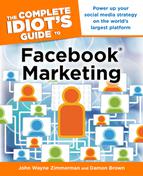Creating Wild Fans
Here’s a secret: people actually want to Like your business. At the end of the day, consumers want reliable producers, consistent brands, and great service. When they find it, they support it.
We assume you’re doing the very best you can with your business, so that part is covered. Now you just need to get your business in front of the right people’s faces. Your Facebook Fan page is the bridge between you and your next customer.
When it comes to customers, “What’s In It For Me?”, or WIIFM, is the main thing they care about. The more quickly you can make clear to them the advantages of working with your business, the faster they will listen—and maybe even purchase your product or service.
| DEFINITION |
WIIFM, short for “What’s In It For Me?”, means that people are more likely to do something for you if it clearly will be beneficial to them.
In traditional sales, WIIFM usually involves convincing someone that buying your service will be in their best interest. In social media marketing—and Facebook marketing in particular—the conversation doesn’t end when customers drive the proverbial car off the lot.
With a Facebook Fan page, the conversation with the consumer continues after the initial sale, as he or she is able to communicate with you about problems with the product, questions about the service, or even references for other potential customers. All the while, WIIFM will have to be paramount in your mind. Here are some tips:
• Don’t just tell customers to “Like our page!” Instead, give them an incentive to Like the page, such as exclusive sales, discounts, or other valuable information.
• Keep content on your Fan page fresh so customers will have incentive to visit regularly and also share your news on their own Facebook page.
• Include all your relevant content information on the Fan page, from customer help lines to all your locations, so customers begin viewing your page as a resource.
Facebook marketing turns a one-directional campaign into a two-way conversation. However, it’s up to you how much you’d like your business to interact with customers. We call it a case of broadcast versus interaction. Here are some examples:
| Broadcast | Interaction |
| Telling followers you’re having a sale | Asking followers what they’d like to see on sale and responding accordingly |
| Posting a customer hotline | Addressing customer concerns directly through the Facebook page |
| Telling customers about changes | Showing customers why changes in policy, procedure, or practice are taking place and including them in the conversation |
| Showing the latest advertisement exclusively on the Facebook page | Asking visitors to vote for their favorite ad |
Interaction gives users an incentive to come back. The downside is that it requires a much bigger time commitment than broadcasting.
| WATCH OUT |
It’s better to be low-key and consistent than to be overambitious and unstable. If some weeks you post a lot of content to your page and then let weeks go by without posting anything, customers may view your business as flaky and unreliable. And be sure to ration your resources to allow for a consistent marketing campaign. In other words, don’t plan a spectacular, interactive December, and have absolutely no resources left to follow up your interactivity in January.
Think about your long-term financial, time, and manpower resources before you push for more interaction on your Fan page.
Domino’s Pizza is one of our favorite cases of broadcast versus interaction. The successful food chain had its 50th anniversary in 2010—and had some of the worst customer feedback compared to its competitors. For CEO Patrick Doyle, the breaking point was receiving a photo from a customer of a delivered pizza: The Domino’s Pizza driver was so sloppy and the toppings were so loose, the pizza toppings smashed up against the top of the box. The carelessness was starting to affect Domino’s Pizza’s sales, too.
The CEO had had enough. In 2010, he started the “We Suck!” campaign, where customers were encouraged to post pictures of Domino’s Pizza’s screw-ups. Wrong toppings, burnt pizzas—anything that the company messed up. He said that his company had to do better, and the only way that was going to happen would be if everyone was held accountable. It was, of course, part of a multi-million-dollar ad campaign, but customers seemed to appreciate the honesty, too: Domino’s Pizza sales went up 16 percent, a serious number for a worldwide corporation.
Beyond the honesty, though, Domino’s Pizza pushed its customers to participate in the revitalization of its brand. By using Facebook and other social media, the company made an impact not by broadcasting, but by interacting.
